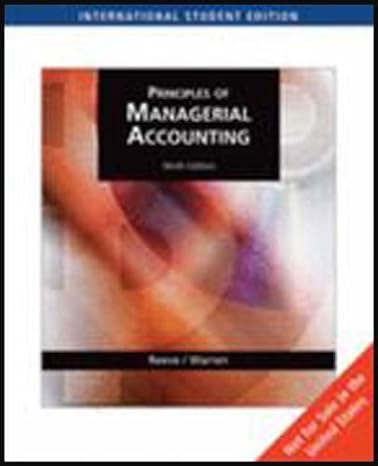Question
A firm uses the audit risk model, AR=RMMxDR, to plan audit programs, as described below. Audit Risk: The firms AR ranges, for any materiality amount,
A firm uses the audit risk model, AR=RMMxDR, to plan audit programs, as described below.
Audit Risk: The firms AR ranges, for any materiality amount, are:
VERY LOW 1% to <5%
LOW 5% to <10%
MODERATE 10% to 30%
HIGH Not permissible
These ranges are modified according to the type of risk, as described below.
If an auditor doesnt specify a numerical risk level for AR, the auditor must specify a category (VL, L or M, but not H). The firms planning software will then assume that VL=1%, L=5% and M=10%.
Preliminary Risk of Material Misstatement, RMMp: This risk is based on the auditors judgment regarding the design effectiveness of the system in place. If the auditor doesnt specify a risk level for RMMp, the auditor must specify a category (VL, L or M or H). The firms planning software will then assume that VL=5%, L=10%, M=30% and H=100%.
Risk of Material Misstatement, RMM: RMM is the auditors assessment of the operating effectiveness of controls, which is determined from the auditors tests of controls.
Detection Risk, DR: The auditor should specify a value for DR that is consistent with AR and RMM.
That is, DR = AR / RMM and is dependent on the auditors choices of AR and RMM. If application of the risk levels for AR and RMM, pursuant to the above guidelines, results in DR50%, then the auditor sets DR=50%. DR > 50% is not permissible under the firms guidelines.
Suppose the auditor specifies only the categories for AR and RMMp, not numerical values. Briefly explain the reason for the firms software planning tool setting AR to the low end of the range for each category and RMM to the high end of the range for each category.
A. The auditor sets AR to LOW, and RMM, the operating effectiveness, is found to be MODERATE. Calculate planned DR in accordance with the planning guideline.
B. The auditor sets AR to LOW, and RMM, the operating effectiveness, is found to be HIGH. Calculate planned DR in accordance with the planning guideline.
C. The auditor sets AR to MODERATE, and RMM, the operating effectiveness, is found to be LOW. Calculate planned DR in accordance with the planning guideline.
3. Assume that scope of the examination remains constant.
A. What effect does increasing the materiality amount have on DR?
B. What effect does increasing the materiality amount have on AR?
4. Assume that the operating effectiveness of controls, RMM, is determined.
A. If M is increased, but AR and DR are unchanged, what is the effect on the scope of the
examination? [Your answer should be either: enhanced, unchanged or reduced]
B. If scope is enhanced, but not AR, what is the possible effect on the amount of misstatement that could
be detected at that fixed level of AR? [This is equivalent to asking: What is the effect on m ?)
(please ans a,b& c)
Step by Step Solution
There are 3 Steps involved in it
Step: 1

Get Instant Access to Expert-Tailored Solutions
See step-by-step solutions with expert insights and AI powered tools for academic success
Step: 2

Step: 3

Ace Your Homework with AI
Get the answers you need in no time with our AI-driven, step-by-step assistance
Get Started


